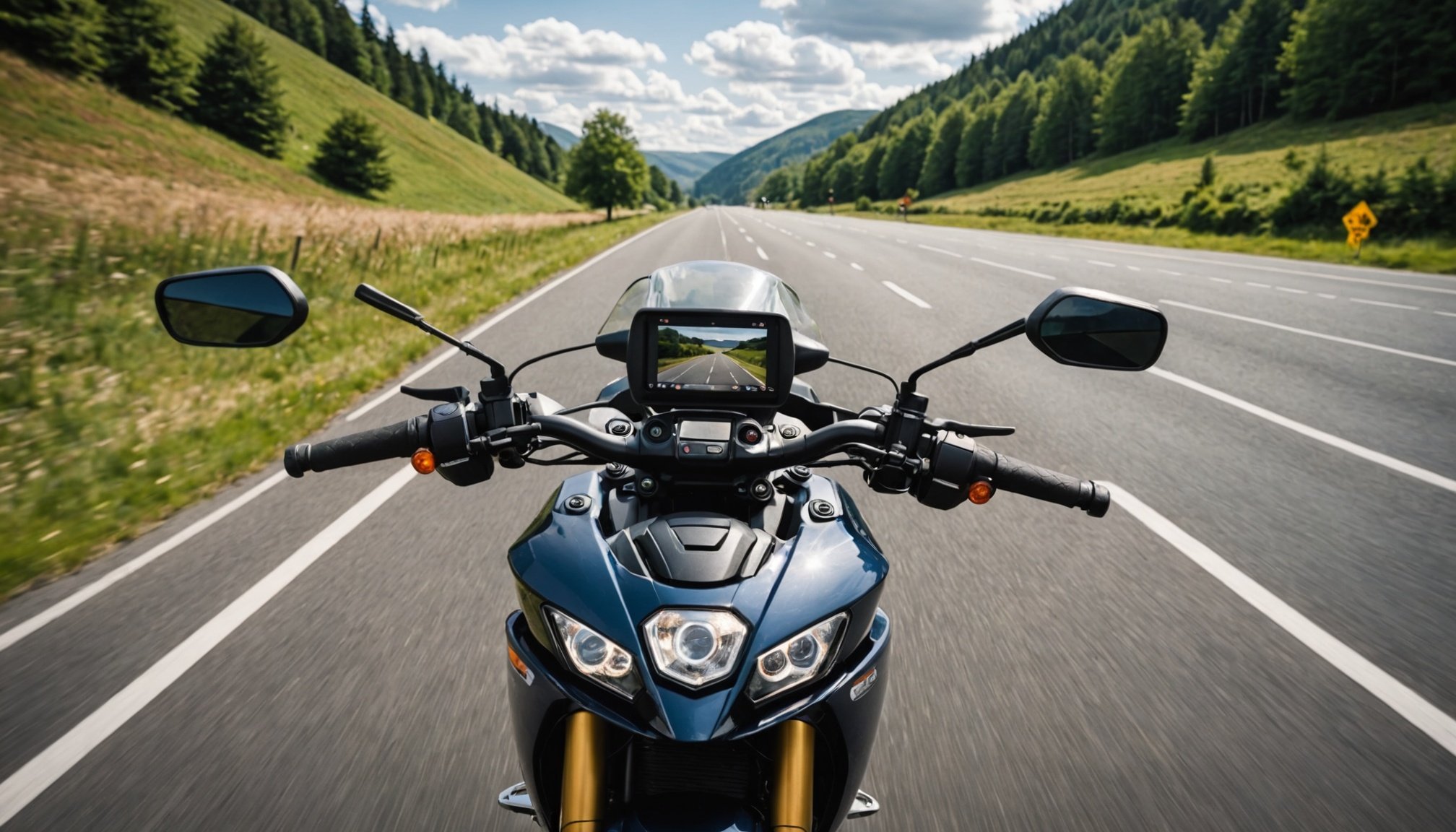Overview of Dash Cameras for Sport Bikes
Dash cameras are becoming an essential tool for road safety, especially for sport bike enthusiasts. These compact devices are designed to record your journey, providing valuable evidence in case of accidents or disputes over road incidents. Given their dual purpose of safety and security, selecting the right dash camera involves considering several key features.
Installation Guide: Proper fitting of dash cameras is crucial. An installation guide tailored for sport bikes ensures the camera is effectively positioned to capture all necessary footage while being shielded from elements like rain or debris. Sport bikes often have less space and different structures compared to cars, making specialised guidance indispensable.
For sport bike riders, the benefits of having a dash camera extend beyond safety. They enable bikers to document their rides and share breathtaking views from their perspectives. Moreover, in an era where video proof can significantly influence insurance claims, having a dash camera may ease the insurance process.
When selecting a dash camera, it’s important to prioritise features like video resolution, waterproof capabilities, and shockproof technology. Such features not only assure quality video capture but also durability and reliability in various riding conditions. Ultimately, the right dash camera enhances both safety and enjoyment for sport bike riders.
Legal Requirements for Dash Cameras in the UK
Navigating the use of dash cameras within UK regulations is essential for sport bike riders who wish to enhance their road safety and compliance. Understanding the dash camera legality in the UK can prevent potential pitfalls when recording journeys.
Overview of UK Laws Regarding Dash Cameras
The UK allows the use of dash cameras, but certain stipulations apply. Riders must ensure their cameras do not obstruct the driver’s view, adhering to the Vehicle Regulations. What’s more, handling and reviewing footage must comply with privacy laws, particularly the Data Protection Act. Failure to comply could attract fines or legal actions.
Requirements for Footage Use in Insurance Claims and Legal Scenarios
Dash camera footage can significantly impact insurance claims, provided it is clear and well-documented. The footage must be delivered in its original format, ensuring authenticity. Riders planning to capture footage for legal defences must ensure it’s relevant to the incident. Always preserve the integrity of your evidence to avoid legal complications.
Potential Penalties for Non-Compliance with Dash Camera Regulations
Non-compliance with road travel compliance could lead to penalties, such as fines or increased insurance premiums. Improper installation or usage could also attract legal scrutiny, especially if privacy protocols are breached. Riders should regularly update themselves on legal requirements to ensure they remain compliant.
Safety Tips for Using Dash Cameras
Using a dash camera not only bolsters road safety, but also when equipped with the right safety tips, it enhances rider experience. An essential practice is to maintain focus on the road: calibrating and adjusting dash cameras should be done prior to your journey. Avoid any interaction while riding to minimise distractions.
It’s crucial to regularly review footage. This practice helps ensure that the camera is capturing clear and accurate images, which is valuable during insurance deliberations. Properly labelled folders and organised archives can simplify future footage retrieval, enhancing its utility.
During installation, pay attention to the dash camera operation—common mistakes include mispositioning the camera or inadequate securing, leading to vibrations and image distortion. Ensure the camera is mounted firmly to capture smooth footage, mitigating any jitters caused by the sport bike’s engine.
Being mindful of privacy laws is paramount. Recording public spaces or individuals can invite unwanted legal attention. Ensuring footage is used respectfully not only aligns with regulations but also maintains ethical standards.
By adhering to these safety tips, riders can ensure their dash cameras remain reliable companions, converting ordinary rides into secured journeys and valuing each recording.
Maintenance and Care for Dash Cameras
Keeping your dash cameras in top condition is crucial for ensuring reliable performance and longevity. Regular dash camera maintenance can help avoid unforeseen technical issues that might compromise the functionality of these essential devices.
Begin with routine checks to verify all components are working correctly. Checking the mount’s sturdiness, ensuring cables remain connected, and confirming the camera’s power up can prevent malfunctions while on the road. Regular attention to these elements can save time and frustration.
Cleaning and storage recommendations play a pivotal role in preserving your device. Gently clean the camera lens using a microfiber cloth to prevent any scratches that might affect video quality. Storing the dash camera in a dust-free, stable environment when not in use helps maintain its optimum condition.
Periodic software and firmware upgrades are also crucial. Manufacturers often release updates that enhance features or fix known bugs, improving both the user experience and the camera’s reliability. Keep abreast of these changes by frequently checking the manufacturer’s website or user manuals.
By adhering to these care tips, you ensure your dash camera remains a trustworthy companion on all journeys, capturing clear and actionable footage and enhancing both safety and security.
Implications of Non-Compliance
Understanding the consequences of not adhering to regulations is crucial for sport bike riders using dash cameras in the UK. Legal implications arise mainly from failing to meet prescribed UK regulations concerning the placement and operation of these devices.
Non-compliance with dash camera legality can result in severe repercussions, such as fines and penalties. One critical requirement is ensuring the camera does not obstruct the rider’s view. Breaching this or privacy laws could lead to financial penalties or even legal action. It’s important for riders to be aware of these regulations to avoid any negative financial or legal outcomes.
Furthermore, non-compliance influences insurance claims. If the dash camera footage does not meet legal standards, insurers may reject it as evidence, possibly affecting the outcome of claims and leading to higher premiums. Incorrect installation can also compromise the footage quality, impacting its utility in legal or insurance scenarios.
Riding with awareness and understanding of these laws protects both personal safety and legal standing. Always ensuring your devices are fully compliant safeguards against fines while providing reliable evidence for any incidents. Prioritising compliance enhances both the safety and peace of mind of sport bike riders.
Selecting the Right Dash Camera
Choosing the best dash cameras for sport bikes requires careful consideration of specific features that enhance not only performance but also compatibility. Sport bike riders have unique needs compared to car drivers, especially given the motorcycle’s exposure to various elements.
Key Features to Look For
High video resolution and frame rates are crucial. They ensure that the footage captured is clear and detailed, which is essential for both safety reviews and insurance purposes. Look for cameras that offer at least 1080p resolution with 60 frames per second for smooth playback.
Recommended Dash Camera Models
Focus on sports bike compatibility, which often means selecting cameras that are compact and designed to withstand harsh environments. Models featuring waterproof and shockproof capabilities are particularly beneficial given the exposure to different weather conditions and vibrations at high speeds.
Budget Considerations
When it comes to cost, balance is key. Novice riders may favour economical models with basic functionality, while seasoned enthusiasts could invest in high-end options that offer advanced features like GPS tracking and Wi-Fi connectivity. Always weigh the cost vs. benefits in accordance with personal riding preferences and needs.
Step-by-Step Installation Guide
Installing dash cameras on sport bikes requires precision and care to ensure functionality and reliability. Proper installation not only enhances safety but also optimises the camera’s performance.
Preparing the Sport Bike for Installation
Begin by selecting a location that offers a clear view and prevents the camera from obstructing your view of the road. Clean the mount area thoroughly to ensure a strong adhesive grip, which is crucial for stability. Consider positions like the handlebars or beside the windscreen for optimal footage capture.
Detailed Wiring Instructions Tailored for Sport Bikes
Sport bikes often possess limited space, making meticulous wiring instructions imperative. Focus on routing the cables along existing lines to avoid clutter and potential interference with bike controls. Use cable ties to secure wires, ensuring they do not dangle loosely, which could disrupt riding or damage the camera.
Tips for Securing the Camera to Avoid Vibrations
Vibrations can compromise video quality and the longevity of dash cameras. To mitigate this, ensure the camera mount is tight and stable. Utilise shock-absorbent mounts or pads specifically designed for sport bikes, which help reduce vibrations caused by high speeds or rough terrains. Regularly check all mounts and connections to maintain steady footage.











